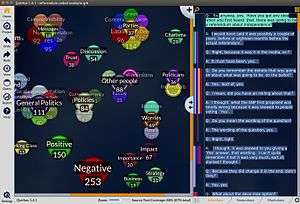Quirkos
|
Screenshot of Quirkos 1.4.1 | |
| Developer(s) | Quirkos Software |
|---|---|
| Stable release |
1.4.1
/ March 2017 |
| Operating system | Microsoft Windows, Linux, macOS |
| Type | Qualitative data analysis, Qualitative Research |
| License | Proprietary |
| Website |
www |
Quirkos is a CAQDAS software package for the qualitative analysis of text data, commonly used in social science. It provides a graphical interface in which the nodes or themes of analysis are represented by bubbles. It is designed primarily for new and non-academic users of qualitative data,[1] to allow them to quickly learn the basics of qualitative data analysis. Although simpler to use, it lacks some of the features present in other commercial CAQDAS packages such as multimedia support and memos. However, it has been proposed as a useful tool for lay and participant led analysis[2] and is comparatively affordable.[3] It is developed by Edinburgh, UK based Quirkos Software, and was first released in October 2014.[4]
The interface is unique, in that it simultaneously displays visualisations and text data[5] and has identical capabilities on Windows, macOS and Linux. The thematic framework is represented with a series of circles, the size of each indicating the amount of data coded to them. Colors are used extensively to indicate the thematic bubble within the coding stripes on the text sources.[6] There are few features for quantitative or statistical analysis of text data, however project files can be exported for analysis in statistical software such as SPSS or R.
Quirkos is extensively used in many different fields which utilise qualitative research, including sociology,[7] health,[8][9] media studies,[10] school of education[11][12] and human geography.[13] The developers claim use in more than 100 universities across the world.[14] It has also been used in research for non-governmental organisations such as the Infection Control Society[15] and UNICEF.[16] However, the text management capabilities also can be used to assist in systematic literature reviews.[17]
Features
- Basic features and simple operation
- Import of Microsoft Word, PDF, Text and RTF source files
- CSV import for tabulated data (such as online surveys)
- Integrated synonym database for keyword search[18]
- Cluster analysis and visualisation of concurrent coding
- Export coded data to annotated Microsoft Word files
- Subset analysis by discrete and quantitative variables
See also
References
- ↑ Gilbert, Nigel (2015). Researching Social Life. SAGE. p. 161. ISBN 1446295451.
- ↑ Fielding, edited by Nigel G.; Lee, Raymond M.; Blank, Grant (2008). The SAGE handbook of online research methods (Repr. ed.). Los Angeles: SAGE. p. 476. ISBN 9781412922937.
- ↑ Kara, Helen (2012). Research and evaluation for busy practitioners : a time-saving guide (1st ed. ed.). Bristol: The Policy Press. p. 168. ISBN 1447301153.
- ↑ "Launch of Quirkos Qual Software". Mr Web. Retrieved 3 April 2017.
- ↑ Saldana, Johnny; Omasta, Matt (2017). Qualitative research: Analyzing Life. Sage. p. 251. ISBN 1506305490.
- ↑ Saldana, Johnny. The Coding Manual for Qualitative Researchers. SAGE. p. 34. ISBN 9781473943599.
- ↑ Gavin, Daker-White, (11 July 2016). "The Social Context of Patient Safety Risks for People Living with Multiple Health Conditions". ISA Forum of Sociology.
- ↑ Anderson, C; Evans, J; Valderas, J.M.; Campbell, S; Daker-White, G. (1 April 2017). "The art of prioritising – people's experiences of dealing with multiple medicines for multimorbidities". International Journal of Pharmacy Practice. 25: 4–39. ISSN 2042-7174. doi:10.1111/ijpp.12367.
- ↑ Ashford, Miriam T.; Ayers, Susan; Olander, Ellinor K. (1 May 2017). "Supporting women with postpartum anxiety: exploring views and experiences of specialist community public health nurses in the UK". Health & Social Care in the Community. 25 (3): 1257–1264. ISSN 1365-2524. doi:10.1111/hsc.12428.
- ↑ Lim, Sun Sun; Soriano, Cheryll. Asian Perspectives on Digital Culture: Emerging Phenomena, Enduring Concepts. Routledge. ISBN 9781317552635.
- ↑ Rodriguez, Marisol (2016). The Career Path of Successful Hispanic Women Holding Top Academic Administrative Positions in Higher Education. ProQuest Dissertaitions Publishing. Retrieved 10 April 2017.
- ↑ M., McKee, Holly (2016). The Construction and Validation of an Instructor Learning Analytics Implementation Model to Support At-Risk Students. Nova Southeastern University. p. 46. Retrieved 10 April 2017.
- ↑ Nizarudin, Norhanis Diyana (28 June 2016). "Spatial and Sociocultural Aspects of Urban Mosque Open Spaces in Kuala Lumpur, Malaysia: A mixed-method approach". Environment-Behaviour Proceedings Journal. 1 (2): 43–51. ISSN 2398-4287. doi:10.21834/e-bpj.v1i2.254. Retrieved 10 April 2017.
- ↑ "Looking back and looking forward to qualitative analysis in 2017". Quirkos Software. Retrieved 10 April 2017.
- ↑ Denton, Andrea (2015). IPS Infection Prevention Society Research Grant Final Report. Infection Prevention Society.
- ↑ A, Bhatti,; Z, Mumtaz; M, Sommers (16 July 2016). "Formative Menstrual Hygiene Management Research: Adolescent Girls in Pakistan.". ERA. Real Medicine Foundation (Pakistan). doi:10.7939/R3F47H57R. Retrieved 10 April 2017.
- ↑ Silver, Christina (1 January 2016). "The value of CAQDAS for systematising literature reviews". Revy. 39 (1): 6–8.
- ↑ Gilbert, Nigel; Stoneman, Paul (2016). Researching Social Life. SAGE. p. 430. ISBN 9781473944237. Retrieved 10 April 2017.
External links
- Official website
- Review by the University of Surrey CAQDAS network
- Software overview (presentation)
- Software overview (video)
